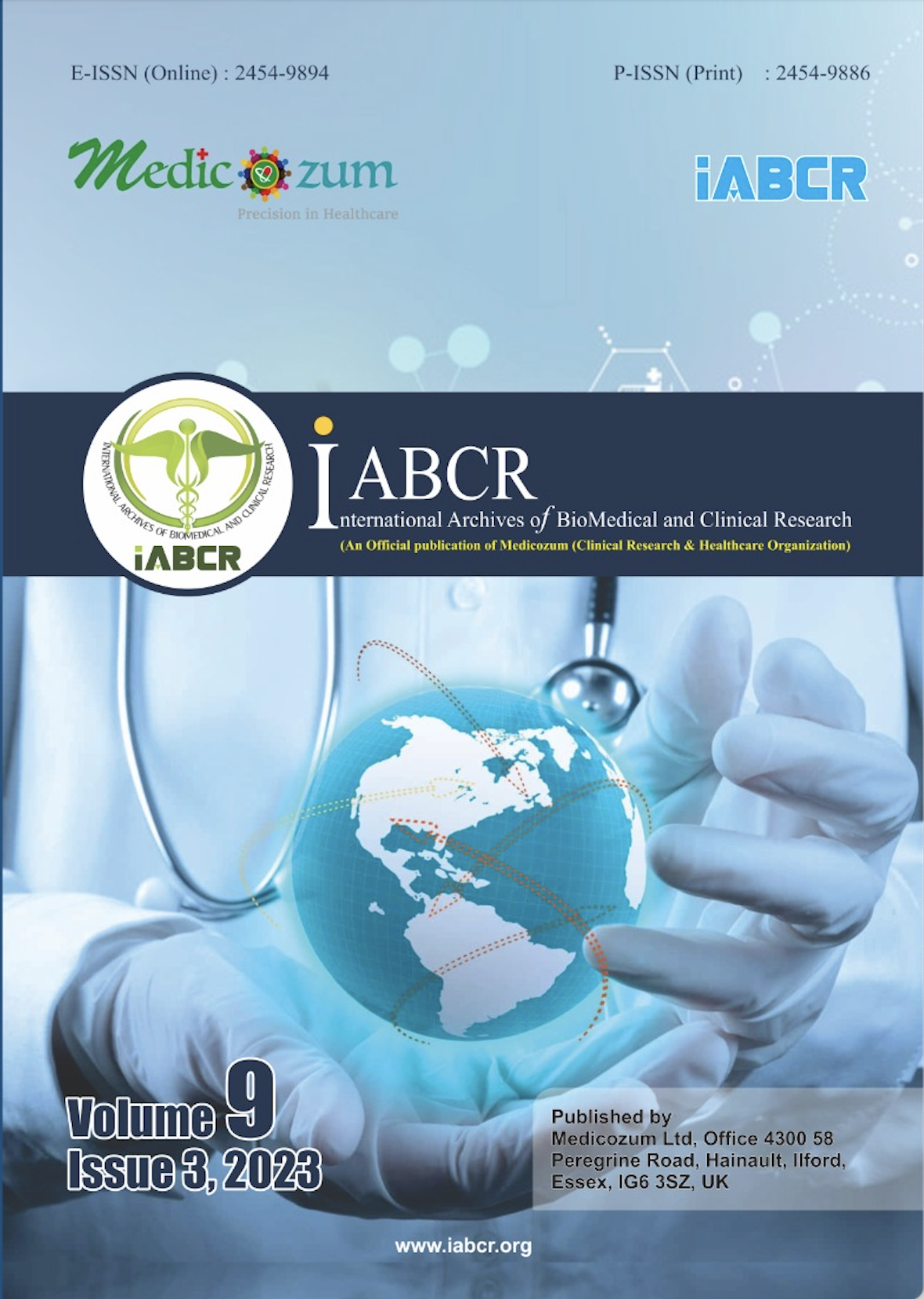State of oxidative stress: Lethal phenomenon for heart and vessels
DOI:
https://doi.org/10.21276/atekhk44Keywords:
Hyperglycemia, hypertension, and hyperlipidemiaAbstract
Hyperglycemia, hypertension, and hyperlipidemia are known as metabolic syndrome. In presence of high levels of blood LDL particles, free radicals (ROS), macrophages, cytokines, platelets, histamine, 5HT get involved in LDL oxidation, leading to formation of atherosclerotic plaques which get deposited in endothelium of coronary arteries causing coronary artery disease (CAD). Psyllium fibers and Ficus Carica (FC) are being considered to be useful in treating hyperlipidemia, hypertension, and hyperglycemia. This study was conducted to determine hypotensive, hypolipidemic, and hypoglycemic potential of Psyllium husk and FC. Study was conducted in National hospital, Lahore, Pakistan from January to April 2020. Seventy five hyperlipidemic, hypertensive and diabetic patients were enrolled selected from the hospital with their consent. They were divided in three groups ie 25 patients in each group. Group-1 was on placebo, group-2 was on 15 grams psyllium husk to be used in three divided doses. Group-3 was on 12 grams FC to be taken in three divided doses daily for two months. Their Lipid profile, FBS, and hypertension were determined before and after two months therapy by these two agents. Two analyze data we used SPSS version 10.01.001 2015 and t test was applied to determine changes in the tested parameters. In two months therapy by psyllium husk in 24 patients TG, TC, LDL-c was reduced 21.48, 10.09, 24.17 mg/dl respectively. HDL was increased 12.38 mg/dl in this group. FBS reduction was 28.66 mg/dl, systolic BP 6.30, and diastolic BP reduced in this group 7.52 mm of mg. We then concluded that FC and PH have good enough potential to normalize lipid profile, reduce BP, and FBS in patients suffering from metabolic syndrome.
Downloads
References
Walker FT, Argawal CG, Singh GP, Ghatak BA. New challenges about metabolic syndrome. Int Med J Eth 2013;12(5):122-9.
Zettwoch N, Feldman T, Tietyen-Clark J, Oeltgen P, Bishop CW. Free Radical formation in human body. Org Chem 2014;6(3):66-9.
Teluj TR, Harris BV, Goldberg AC. Reactive oxygen species and coronary artery disease. Ann SMC 2015;8(4):100-106.
Fithgut FD, Rao VA, Collier GR. CAD is dangerous? Or ROS ?. Int J Chem 2016;18(7):234-7.
Aulejay HG, Gustafson NJ, Bryant CA, Tietyen-Clark J. Deterioration of DM type-2. Diab J 2012;6(5):129-11.
Sulhar TT, Berman ER. How to handle atherogenesis rightly?. J Cl Med 2016;5(2):555-9.
Ajoka TG, Roberts DC, Truswell AS. Medicinal herbs for metabolic disorders. CMJ 2012;8(12):457-60.
Hinoskvy TR, Jenkins AL. Bile acid binding resins for HL. J lipids 2014;17(4):876-80.
Jamah VG, Helkur TT, Nuttall FQ. GIT is cause of 100 metabolic disorders. GIT J 2015;17(8):1009-13.
Phalar TK, Savage PJ. Figs are used as antioxidents. JOS 2016;7(3):666-70.
Filoha JJ, Minaker KL. Phytochemistry of Ficus Carica. J Eth Bot 2015;16(7):453-9.
Tietyen CC, Fredrickson DS. Effects of Figs in diabetes mellitus type-2. Diab J Pr Med 2015;8(1):99-105.
Maggio VL, Miller DT, Hannon WH. How free radicals burden is reduced?: Nutraceuticals role. Pre Med J 2013;7(4)109-15.
Juba C, Ward K. GI mucosa and fruits are key to keep blood clean. New J herb Med 2016;2(4):99-106.
Samble T, Hizu P, Mok J. Conventional method for Metabolic syndrome treatment. JKUI 2015;45(8):1009-13.
Jan M, Kamran R, Sadia H, Hamid S. Few things to get well from heart disease CAD. Pak J Pr Drug 2012;11(7):122-30.
Yulve ST, Hyli GH, Hetrok LL. Use of nutraceuticals in prophylactic therapy. J Int Med SA 2013;12(1)66-70
Jabu E, Sabwt L, Jehuja V, Urlewq T. How BABRs work in dyslipidemia. JIPM 2014;3(1):333-6.
Forhavve C, Tertrah R, Muloza Y, Umbeh R. Psyllium husk and DM type-2. Met Dis J 2012;12(5):67-71.
Boharr G, Sotha J, Kimsa P, Hytwve R. Some pharmacological effects of PHM. Prev Did J 2013;3(8):212-8.
Ginji P, Jukasa L, Uyetr C, Ufsarv V. Figs as antioxidant agents. Ind J JU 2013;7(3)104-9.
Tumarsin J, Yesh J, Hirmath F, Parkash L. Indian Figs as anti-inflammatory agents. Ind J Cl Med 2015;14(7):199-202.
Vijay K, Sanjnani R, latadevi S, Shakta V. Phytochemistry of Figs. IJPS 2014;10(4):457-9.
Toorah C, Joorah T, Pilka T, Gurhar T. New slant on Ficus Carica. Ann Pr Med Dent 2015;7(4):122-8.
Mulakarv T, Olasv J, Yetmar F, Traesq M. Apoprotein formation by herbs. J Herb Med Ther 2015;17(7):346-9.
Murrdare G, Penkat J, Musooj T, Jehui T. Herbs causing allergy and inflammation. Is J Cl Pr Ther 2016;4(3)77-80.
Feghato R, Yelmz E, Felhez C, Relav T. Effects of metabolites from Figs. SSMS 2014;4(7):88-91.
Erosj JK, Walker TR, Bhunar FG. Treatment of DMT2 by herbal medication. Medniyat J 2013;5(7):188-90.
Downloads
Published
Issue
Section
License
Copyright (c) 2025 Zafar H Tanveer, Sajida Zafar, Ali Abuzar Raza, Rabia Zafar, Jamil Ahmed Lakhair, Shah Murad, Shaheena, Ajaz Fatima (Author)

This work is licensed under a Creative Commons Attribution-NonCommercial 4.0 International License.
Authors are required to sign and submit the completed “Copyright transfer Form” upon acceptance of publication of the paper. This is determined by a publishing agreement between the author and International Archives of Biomedical and Clinical Research. These rights might include the right to publish, communicate and distribute online. Author(s) retain the copyright of their work. International Archives of Biomedical and Clinical Research supports the need for authors to share, disseminate and maximize the impact of their research.













